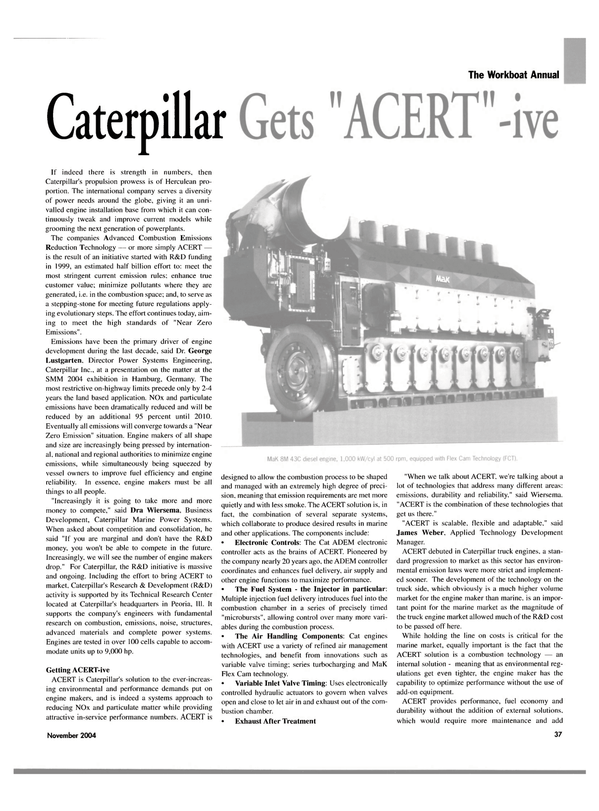
Caterpillar Gets "ACERT"-ive
If indeed there is strength in numbers, then Caterpillar's propulsion prowess is of Herculean proportion.
The international company serves a diversity of power needs around the globe, giving it an unrivalled engine installation base from which it can continuously tweak and improve current models while grooming the next generation of powerplants.
The companies Advanced Combustion Emissions Reduction Technology — or more simply ACERT — is the result of an initiative started with R&D funding in 1999, an estimated half billion effort to: meet the most stringent current emission rules: enhance true customer value; minimize pollutants where they are generated, i.e. in the combustion space; and, to serve as a stepping-stone for meeting future regulations applying evolutionary steps. The effort continues today, aiming to meet the high standards of "Near Zero Emissions".
Emissions have been the primary driver of engine development during the last decade, said Dr. George Lustgarten, Director Power Systems Engineering, Caterpillar Inc., at a presentation on the matter at the SMM 2004 exhibition in Hamburg, Germany. The most restrictive on-highway limits precede only by 2-4 years the land based application. NOx and particulate emissions have been dramatically reduced and will be reduced by an additional 95 percent until 2010.
Eventually all emissions will converge towards a "Near Zero Emission" situation. Engine makers of all shape and size are increasingly being pressed by international, national and regional authorities to minimize engine emissions, while simultaneously being squeezed by vessel owners to improve fuel efficiency and engine reliability. In essence, engine makers must be all things to all people.
"Increasingly it is going to take more and more money to compete," said Dra Wiersema, Business Development, Caterpillar Marine Power Systems.
When asked about competition and consolidation, he said "If you are marginal and don't have the R&D money, you won't be able to compete in the future.
Increasingly, we will see the number of engine makers drop." For Caterpillar, the R&D initiative is massive and ongoing. Including the effort to bring ACERT to market. Caterpillar's Research & Development (R&D) activity is supported by its Technical Research Center [...] located at Caterpillar's headquarters in Peoria, 111. It supports the company's engineers with fundamental research on combustion, emissions, noise, structures, advanced materials and complete power systems.
Engines are tested in over 100 cells capable to accommodate units up to 9,000 hp.
Getting ACERT-ive ACERT is Caterpillar's solution to the ever-increasing environmental and performance demands put on engine makers, and is indeed a systems approach to reducing NOx and particulate matter while providing attractive in-service performance numbers. ACERT is designed to allow the combustion process to be shaped and managed with an extremely high degree of precision, meaning that emission requirements are met more quietly and with less smoke. The ACERT solution is, in fact, the combination of several separate systems, which collaborate to produce desired results in marine and other applications. The components include: • Electronic Controls: The Cat ADEM electronic controller acts as the brains of ACERT. Pioneered by the company nearly 20 years ago, the ADEM controller coordinates and enhances fuel delivery, air supply and other engine functions to maximize performance.
• The Fuel System - the Injector in particular: Multiple injection fuel delivery introduces fuel into the combustion chamber in a series of precisely timed "microbursts", allowing control over many more variables during the combustion process.
• The Air Handling Components: Cat engines with ACERT use a variety of refined air management technologies, and benefit from innovations such as variable valve timing; series turbocharging and MaK Flex Cam technology.
• Variable Inlet Valve Timing: Uses electronically controlled hydraulic actuators to govern when valves open and close to let air in and exhaust out of the combustion chamber.
• Exhaust After Treatment "When we talk about ACERT. we're talking about a lot of technologies that address many different areas: emissions, durability and reliability." said Wiersema.
"ACERT is the combination of these technologies that get us there." "ACERT is scalable, flexible and adaptable," said James Weber, Applied Technology Development Manager.
ACERT debuted in Caterpillar truck engines, a standard progression to market as this sector has environmental emission laws were more strict and implemented sooner. The development of the technology on the truck side, which obviously is a much higher volume market for the engine maker than marine, is an important point for the marine market as the magnitude of the truck engine market allowed much of the R&D cost to be passed off here.
While holding the line on costs is critical for the marine market, equally important is the fact that the ACERT solution is a combustion technology — an internal solution - meaning that as environmental regulations get even tighter, the engine maker has the capability to optimize performance without the use of add-on equipment.
ACERT provides performance, fuel economy and durability without the addition of external solutions, which would require more maintenance and add
Read Caterpillar Gets "ACERT"-ive in Pdf, Flash or Html5 edition of November 2004 Maritime Reporter
Other stories from November 2004 issue
Content
- Austal Launches 417 ft. Aluminum Ship page: 9
- Design Completed for Steamship Authority Ferry page: 9
- Blount to Deliver MV Isleno page: 10
- SF Bay Ferry Logs Impressive Performance page: 11
- NASSCO Holds Ceremony for Fourth BP Tanker page: 12
- K&C Wins $6M Navy Contract page: 12
- Air Emissions from Ships page: 14
- Shipboard Training Comes of Age page: 17
- Demystifying Parametric Roll page: 20
- A Bright Spot in Oil Patch Vessel Construction page: 26
- Senesco Marine Signs Contract For 140,000-Barrel DH ATB page: 30
- Coffee Company Investigates MContainer-on-BargeM Service page: 31
- USCG Invests in Low Engine Exhaust Temps page: 33
- Seacraft Delivers RV Hercules page: 36
- Caterpillar Gets "ACERT"-ive page: 37
- Making the Mark For Crescent Towing's Fleet page: 40
- The New Wartsila 46F page: 41
- Market Vision with Wartsila s Ole Johansson page: 42
- VT Halter Launches PCTC page: 44
- Aluminum Industry Continues Support for the Marine Market page: 46
- Film Celebrates Golden Age of NW Boats page: 47
- Pressure Transmitter Receives ABS Approval page: 48
- Fire Prevention: "Rising" to the Occasion page: 48
- For Those in Peril page: 50
- A Future in Composites page: 52
- Extra Value in Chinese Construction page: 53
- Record Spend on Propulsion? page: 54
- Collaboration Creates Vehicle for CNG Solutions page: 56
- Milestone Reference with MAN B&W page: 58
- The Will for Business page: 58
- Wider Remit for Dutch Matchmaker page: 58
- 2n d Generation Onboard NAPA Tanker Released page: 58
- Nichols Named "Maritime Man of the Year" page: 59
- ACBL Makes Appointments page: 59
- International Paint Japan K.K. - Open for Business page: 60
- European Yard Initiative - Will it Work? page: 62
- A.P. Meller-Maersk Creates Dedicated Tech Group page: 64
- SembCorp Signs Breakthrough, Long Term LNG Deal page: 66
- Keppel Batangas Completes SemiSub Repair page: 68
- A&P Tyne Re-Delivers FPSO Haewene Brim page: 68
- Crane Materials Launches TimberGuard page: 70
- Fincantieri Orders Water- Lubed Shaft Bearings page: 70
- Bilge Water Treatment Unit Approved By LR page: 71
- Electric Propulsion for Coastal Ships page: 72
- ALSTOM Wins $102M Navy Deal page: 73
- Offshore & Marine Chose Vacon AC Drives page: 73
- Successful Full Load Operation of 5-MW Ship Propulsion Motor page: 74
- Innovative Tweendeck Patented in U.S. page: 76
- MAN B&W Records Busy Hamburg Show page: 77
- Transas Demonstrates New Tech at SMM page: 77
- BV Launches Project Management Solution page: 78
- Xantic Offers New Web-Based Tool page: 79
- New AIS Targets U.S. Workboat Market page: 80
- Hepworth Makes a Good Show at SMM page: 80
- New PVC-Free Alternatives for Interior Decoration page: 80
- A High-End Global Satcom Presence page: 82
- IPS Marine Lands New Blue Chip Casino page: 85
- Rigdon Marine Promotes Harkness to CFO Post page: 85
- Tidewater: Effects of New Tax Bill Are Positive page: 86
- Bollinger to Design, Build Five DH Hot Oil Barges page: 87
- B+V Wins Passenger Ship Contract page: 88
- In Remembrance: Captain Fred Kosnac Jr. (1928-2004) page: 92
- Electronic Charting Aboard APL China page: 93
- Electric Boat Optimizes Nuclear Sub Repairs page: 94
- Kramek, Liu Snare Top SNAME Honors page: 97


